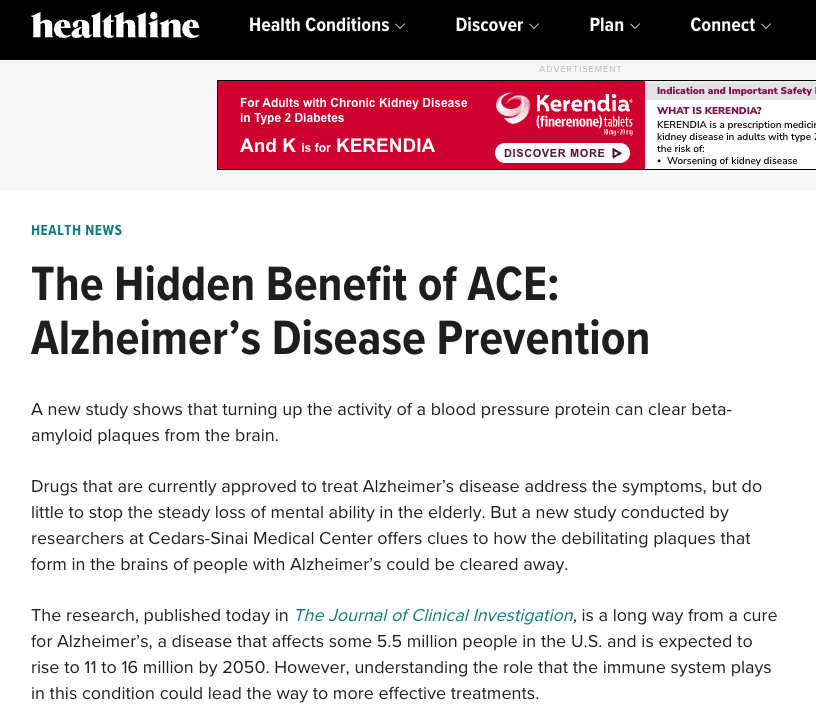
HEALTH NEWS
The Hidden Benefit of ACE: Alzheimer’s Disease Prevention
A new study shows that turning up the activity of a blood pressure protein can clear beta-amyloid plaques from the brain.
Drugs that are currently approved to treat Alzheimer’s disease address the symptoms, but do little to stop the steady loss of mental ability in the elderly. But a new study conducted by researchers at Cedars-Sinai Medical Center offers clues to how the debilitating plaques that form in the brains of people with Alzheimer’s could be cleared away.
The research, published today in The Journal of Clinical Investigation, is a long way from a cure for Alzheimer’s, a disease that affects some 5.5 million people in the U.S. and is expected to rise to 11 to 16 million by 2050. However, understanding the role that the immune system plays in this condition could lead the way to more effective treatments.
Read More: A Brief History of Alzheimer’s Disease »
Ramping Up ACE Protects the Brain
Researchers focused on a naturally-occurring protein—angiotensin-converting enzyme, or ACE—that is found throughout the body. This enzyme is best known for its role in controlling blood pressure. Drugs called ACE inhibitors are used to treat high blood pressure by blocking the activity of the enzyme, leading to a widening of the blood vessels and a drop in blood pressure.
But instead of lowering the effects of ACE, researchers ramped it up in specific cells in the immune systems of mice—including monocytes, macrophages, and microglia. Mice with the super-activated immune cells were then crossbred with mice that were genetically engineered to develop Alzheimer’s disease.
Results showed that the offspring were protected from the effects of Alzheimer’s. In lab tests, their learning and memory skills were similar to those of normal mice. In addition, their brains showed a reduction in a protein—beta-amyloid—that has been associated with Alzheimer’s disease in humans. There was also a decrease in the number of brain plaques that occur when beta-amyloid proteins clump together.
After initial tests, the researchers gave ACE inhibitors to the offspring mice. This reversed the brain benefits they experienced, implying that the enzyme was, in fact, responsible for protecting them from symptoms of Alzheimer’s.
“We were absolutely astonished by the lack of Alzheimer’s-associated pathology in the crossed mice at the age of seven months and again at a 13-month follow-up,” said senior author Maya Koronyo-Hamaoui, an assistant professor of neurosurgery at Cedars-Sinai Medical Center, in a press release. “Even more importantly, this strategy resulted in a near-complete prevention of the cognitive decline in this mouse model of Alzheimer’s disease.”
Learn More: What Causes Alzheimer’s Disease? »
Enzyme Clears Away Brain Plaques
Alzheimer’s is an age-related brain disorder that develops over a period of years. More than 90 percent of cases start after the age of 65, and symptoms include memory loss, confusion, and difficulty recognizing family and friends. Four drugs have been approved by the Food and Drug Administration (FDA) treat the symptoms of Alzheimer’s disease, but they don’t slow it’s progression, which eventually leads to a severe loss of mental function.
Accumulation of beta-amyloid proteins in the brain—both in free form and as plaques—is associated with Alzheimer’s disease, although scientists still don’t know whether they directly cause the decline in mental ability. It is thought that the proteins may damage and destroy brain cells, as well as cause inflammation in the brain that further reduces mental function.
Scientists also don’t know if the beta-amyloid proteins accumulate because the brain produces too much of them, or because the brain is unable to remove them quickly enough.
By increasing the amount of ACE produced by immune cells that enter the brain, however, the researchers in this study were able to speed up the process by which beta-amyloid proteins are broken down and removed by the immune cells.
Know the Signs and Symptoms of Alzheimer’s Disease »
A Two-Pronged Approach To Prevention
Because this research was done in mice, it will be a long time before it leads to practical treatments for Alzheimer’s disease in humans. In their paper, the researchers emphasize that, more importantly, their work proves that a two-prong approach to preventing damage done by beta-amyloid plaques in the brain can be successful.
“While it is possible to envision a strategy for delivering ACE-overexpressing monocytes to patients,” the authors wrote, “perhaps the most informative finding of our studies is the effectiveness of combining an approach to enhance the immune response with that of delivering inflammatory cells to… destroy beta-amyloid.”
